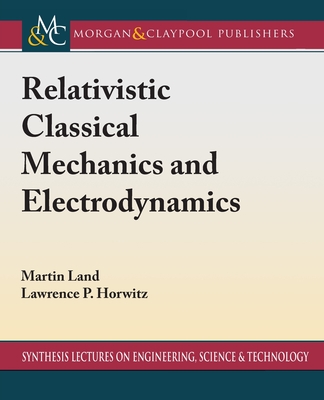Analytical Mechanics for Relativity And Quantum Mechanics (Hardcover) (書側有些許黴斑,不介意在下單)
暫譯: 相對論與量子力學的分析力學 (精裝本)
Oliver Johns
- 出版商: Oxford University
- 出版日期: 2005-09-01
- 售價: $1,450
- 貴賓價: 9.8 折 $1,421
- 語言: 英文
- 頁數: 626
- 裝訂: Hardcover
- ISBN: 019856726X
- ISBN-13: 9780198567264
-
相關分類:
物理學 Physics
下單後立即進貨 (約5~7天)
買這商品的人也買了...
-
 C++ Builder 6 完全攻略
C++ Builder 6 完全攻略$690$587 -
 ASP.NET 1.0 教學手冊-使用 VB.NET (Beginning ASP.NET 1.0 with VB.NET)
ASP.NET 1.0 教學手冊-使用 VB.NET (Beginning ASP.NET 1.0 with VB.NET)$680$537 -
 電腦輔助電路設計─使用OrCAD Pspice A/D 9.2.3 視窗版
電腦輔助電路設計─使用OrCAD Pspice A/D 9.2.3 視窗版$540$529 -
 如何設計 HTML 與 ASP 程式
如何設計 HTML 與 ASP 程式$480$408 -
 Pro/Engineer Wildfire 零件設計進階篇(上)
Pro/Engineer Wildfire 零件設計進階篇(上)$149$149 -
 舞動 Dreamweaver MX 2004 動態網頁設計中文版
舞動 Dreamweaver MX 2004 動態網頁設計中文版$480$480 -
 Linux iptables 技術實務─防火牆、頻寬管理、連線管制
Linux iptables 技術實務─防火牆、頻寬管理、連線管制$620$527 -
 Web CSS 網頁樣式設計學 (Cascading Style Sheets Standard Design Guide)
Web CSS 網頁樣式設計學 (Cascading Style Sheets Standard Design Guide)$580$452 -
 打造個性化 XOOPS2 網站─佈景設計、模組開發
打造個性化 XOOPS2 網站─佈景設計、模組開發$580$493 -
 征服 C 語言程式設計─資料結構與程式設計競賽精解
征服 C 語言程式設計─資料結構與程式設計競賽精解$470$371 -
 嵌入式系統的即時概念 (Real-Time Concepts for Embedded Systems)
嵌入式系統的即時概念 (Real-Time Concepts for Embedded Systems)$550$495 -
 VoIP 網路電話技術
VoIP 網路電話技術$350$277 -
 Linux 核心開發指南 (Linux Kernel Development, 2/e)
Linux 核心開發指南 (Linux Kernel Development, 2/e)$550$495 -
 速習!網站設計達人講座
速習!網站設計達人講座$480$408 -
 計算機概論 (Computer Science: an Overview, 8/e)
計算機概論 (Computer Science: an Overview, 8/e)$550$523 -
 精通 Spring Framework
精通 Spring Framework$580$452 -
 Novell SUSE Linux Enterprise Server 9 管理手冊
Novell SUSE Linux Enterprise Server 9 管理手冊$550$435 -
 PHP PEAR 嚴選程式庫
PHP PEAR 嚴選程式庫$580$493 -
 資料庫系統原理 (Fundamentals of Database Systems, 4/e)
資料庫系統原理 (Fundamentals of Database Systems, 4/e)$860$679 -
 深入淺出 Java 程式設計, 2/e (Head First Java, 2/e)
深入淺出 Java 程式設計, 2/e (Head First Java, 2/e)$880$695 -
 SQL Server 2005 Reporting Services 報表服務實務應用
SQL Server 2005 Reporting Services 報表服務實務應用$620$484 -
 邏輯思考的技術
邏輯思考的技術$300$237 -
 SQL Server 2005 資料庫管理
SQL Server 2005 資料庫管理$680$537 -
 次世代─Linux Ubuntu 玩全手冊
次世代─Linux Ubuntu 玩全手冊$580$493 -
 A First Course in General Relativity, 3/e (Hardcover)
A First Course in General Relativity, 3/e (Hardcover)$1,550$1,519
相關主題
商品描述
因書籍出版日期年代久遠,廠商目前剩餘庫存皆不佳,如不介意在下訂,感謝~~
Description
This book provides an innovative and mathematically sound treatment of the foundations of analytical mechanics and the relation of classical mechanics to relativity and quantum theory. It is intended for use at the graduate level.
A distinguishing feature of the book is its integration of special relativity into the teaching of classical mechanics. Extended Lagrangian and Hamiltonian methods are introduced that treat time as a transformable coordinate rather than the fixed parameter of Newtonian physics. Advanced topics such as covariant Lagrangians and Hamiltonians, canonical transformations, and the Hamilton-Jacobi equation are developed using this extended theory. This permits the Lorentz transformation of special relativity to become a canonical transformation.This is also a book for those who study analytical mechanics as a preliminary to a critical exploration of quantum mechanics. Comparisons to quantum mechanics appear throughout the text, and classical mechanics itself is presented in a way that will aid the reader in the study of quantum theory. A chapter is devoted to linear vector operators and dyadics, including a comparison to the bra-ket notation of quantum mechanics. Rotations are presented using an operator formalism similar to that used in quantum theory, and the definition of the Euler angles follows the quantum mechanical convention. The extended Hamiltonian theory with time as a coordinate is compared to Dirac's formalism of primary phase space constraints. The chapter on relativistic mechanics shows how to use covariant Hamiltonian theory to write the Klein-Gordon and Dirac equations. The chapter on Hamilton-Jacobi theory includes a discussion of the closely related Bohm hidden variable model of quantum mechanics.The book provides a necessary bridge to carry graduate students from their previous undergraduate classical mechanics courses to the future study of advanced relativity and quantum theory. Several of the current fundamental problems in theoretical physics---the development of quantum information technology, and the problem of quantizing the gravitational field, to name two---require a rethinking of the quantum-classical connection. This text is intended to encourage the retention or restoration of introductory graduate analytical mechanics courses. It is written for the intellectually curious graduate student, and the teacher who values mathematical precision in addition to accessibility.
Part I: Introduction: The Traditional Theory1. Basic Dynamics of Point Particles and Collections2. Introduction to Lagrangian Mechanics3. Lagrangian Theory of Constraints4. Introduction to Hamiltonian Mechanics5. The Calculus of Variations6. Hamilton's Principle7. Linear Operators and Dyadics8. Kinematics of Rotation9. Rotational Dynamics10. Small Vibrations about EquilibriumPart II: Mechanics with Time as a Coordinate11. Lagrangian Mechanics with Time as a Coordinate12. Hamiltonian Mechanics with Time as a Coordinate13. Hamilton's Principle and Noether's Theorem14. Relativity and Spacetime15. Fourvectors and Operators16. Relativistic Mechanics17. Canonical Transformations18. Generating Functions19. Hamilton-Jacobi TheoryPart III: Mathematical AppendicesA. Vector FundamentalsB. Matrices and DeterminantsC. Eigenvalue Problem with General MetricD. The Calculus of Many VariablesE. Geometry of Phase Space
商品描述(中文翻譯)
因書籍出版日期年代久遠,廠商目前剩餘庫存皆不佳,如不介意在下訂,感謝~~
描述
本書提供了一種創新且數學上合理的分析力學基礎處理,以及經典力學與相對論和量子理論之間的關係。此書適用於研究生層級。
本書的一個顯著特點是將特殊相對論整合進經典力學的教學中。引入了擴展的拉格朗日和哈密頓方法,將時間視為可變坐標,而非牛頓物理中的固定參數。使用這一擴展理論發展了協變拉格朗日和哈密頓、正則變換以及哈密頓-雅可比方程等高級主題。這使得特殊相對論的洛倫茲變換成為一種正則變換。
這本書也是那些研究分析力學以作為對量子力學進行批判性探索的初步準備的讀者的參考書。全書中不斷出現與量子力學的比較,經典力學本身的呈現方式將有助於讀者學習量子理論。書中有一章專門討論線性向量算子和二次元,並與量子力學的bra-ket符號進行比較。旋轉的介紹使用了類似於量子理論中的算子形式,歐拉角的定義遵循量子力學的慣例。將時間作為坐標的擴展哈密頓理論與狄拉克的主要相位空間約束形式進行比較。關於相對論力學的章節展示了如何使用協變哈密頓理論來寫出克萊因-戈登方程和狄拉克方程。哈密頓-雅可比理論的章節包括對與之密切相關的波姆隱變量模型的討論。
本書提供了一座必要的橋樑,幫助研究生從他們之前的本科經典力學課程過渡到未來的高級相對論和量子理論學習。當前理論物理中的幾個基本問題——例如量子信息技術的發展和量子化重力場的問題——需要重新思考量子與經典之間的聯繫。本書旨在鼓勵保留或恢復入門的研究生分析力學課程。它是為那些對知識充滿好奇的研究生以及重視數學精確性和可及性的教師所寫。
目錄
第一部分:介紹:傳統理論
1. 點粒子及其集合的基本動力學
2. 拉格朗日力學簡介
3. 約束的拉格朗日理論
4. 哈密頓力學簡介
5. 變分法
6. 哈密頓原理
7. 線性算子和二次元
8. 旋轉的運動學
9. 旋轉動力學
10. 平衡附近的小振動
第二部分:時間作為坐標的力學
11. 以時間為坐標的拉格朗日力學
12. 以時間為坐標的哈密頓力學
13. 哈密頓原理與諾特定理
14. 相對論與時空
15. 四向量與算子
16. 相對論力學
17. 正則變換
18. 生成函數
19. 哈密頓-雅可比理論
第三部分:數學附錄
A. 向量基礎
B. 矩陣與行列式
C. 一般度量下的特徵值問題
































